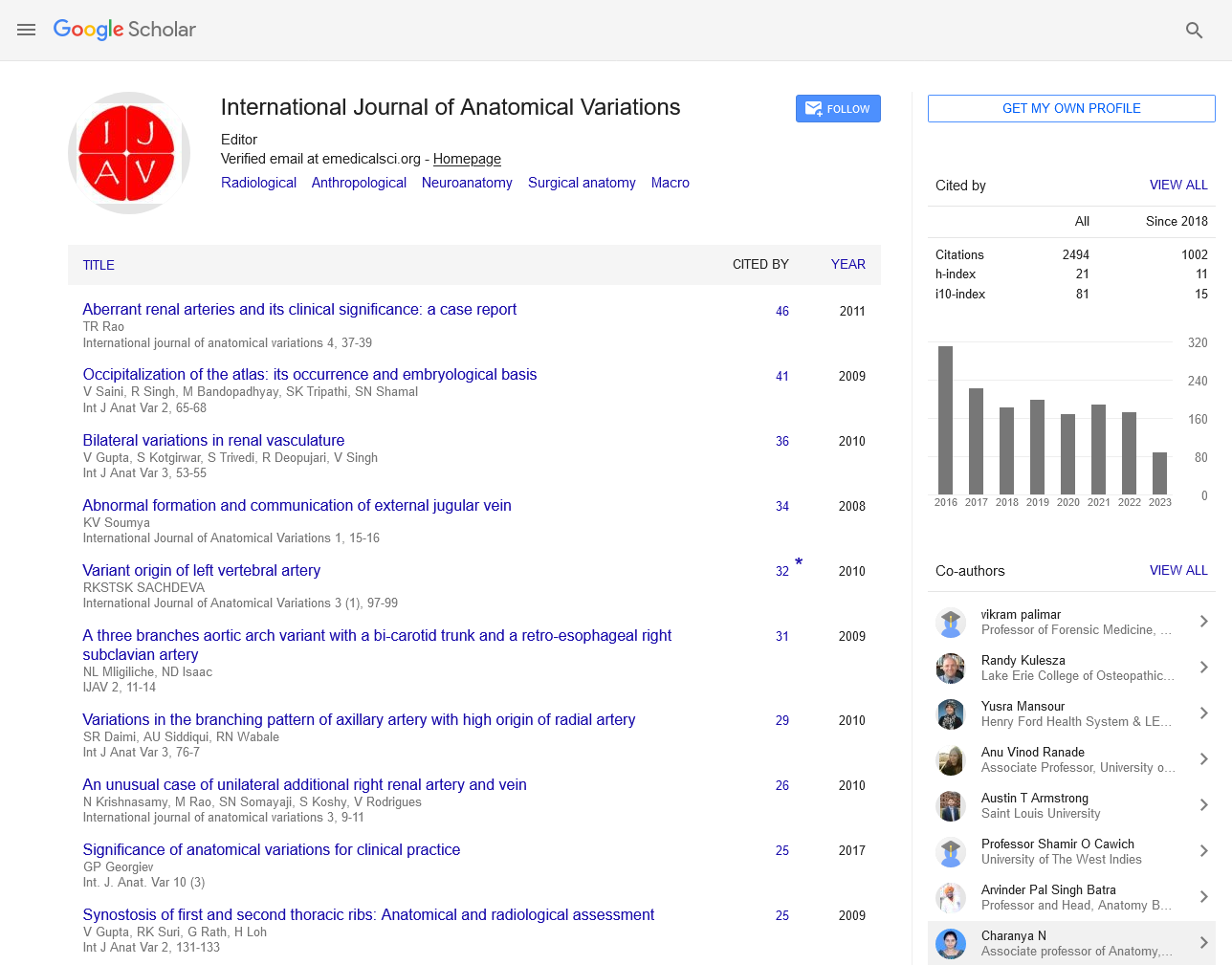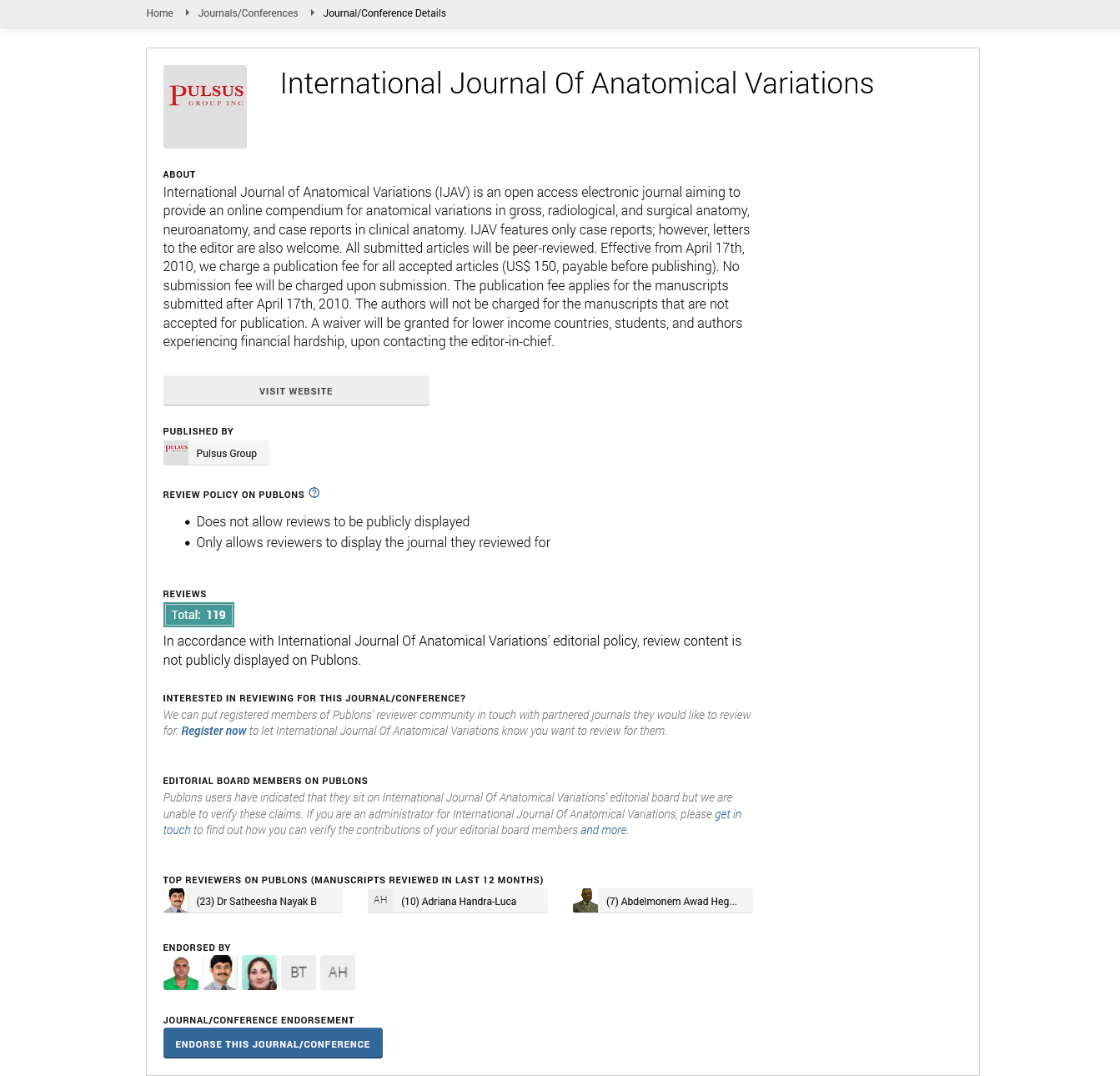Phytotomy An Integrative Overview of Plant Anatomy and Its Relevance to Botanical Science
Received: 01-Apr-2025, Manuscript No. ijav-25-7674; Editor assigned: 04-Apr-2025, Pre QC No. ijav-25-7674 (PQ); Reviewed: 21-Apr-2025 QC No. ijav-25-7674; Revised: 26-Apr-2025, Manuscript No. ijav-25-7674 (R); Published: 30-Apr-2025, DOI: 10.37532/13084038.18(4).508
Citation: Adam J. Phytotomy an Integrative Overview of Plant Anatomy and Its Relevance to Botanical Science. Int J Anat Var. 2025; 18(4): 783-783.
This open-access article is distributed under the terms of the Creative Commons Attribution Non-Commercial License (CC BY-NC) (http://creativecommons.org/licenses/by-nc/4.0/), which permits reuse, distribution and reproduction of the article, provided that the original work is properly cited and the reuse is restricted to noncommercial purposes. For commercial reuse, contact reprints@pulsus.com
Abstract
Phytotomy, or plant anatomy, is the study of the internal structure of plants. This field is fundamental for understanding plant function, development, and adaptation. This article provides a comprehensive overview of phytotomy, encompassing the structural organization of plant cells, tissues, and organs. We highlight key anatomical features in roots, stems, and leaves, explore the evolutionary adaptations in vascular plants, and discuss how phytotomy contributes to fields such as taxonomy, physiology, and ecology. The study also considers emerging methodologies in plant anatomical research, including digital imaging and molecular techniques.
INTRODUCTION
Phytotomy, derived from the Greek words "phyton" (plant) and "tome" (cutting), refers to the anatomical study of plant structures [1]. Historically rooted in descriptive botany, modern phytotomy integrates microscopic analysis, physiological context, and evolutionary implications. Understanding plant anatomy is vital for interpreting plant function, growth, and interactions with the environment. This paper aims to delineate the essential concepts of phytotomy and illustrate its significance across botanical disciplines [2].
HISTORICAL BACKGROUND
The exploration of plant structure dates back to Theophrastus in ancient Greece, but significant progress began with the invention of the microscope in the 17th century. Pioneers like Marcello Malpighi and Nehemiah Grew laid the foundation for modern plant anatomy, describing vascular tissues and cellular organization. The 19th and 20th centuries saw advances in histological staining, electron microscopy, and histochemistry, enriching our understanding of cellular and subcellular structures [3].
PLANT CELL TYPES AND STRUCTURES
Plant cells are characterized by rigid cell walls composed of cellulose, hemicellulose, and lignin. Internally, they possess typical eukaryotic organelles such as the nucleus, mitochondria, and plastids—particularly chloroplasts for photosynthesis. The vacuole plays a key role in turgor pressure and storage [4].
Plant Tissues
Plant tissues are broadly categorized into **meristematic** and **permanent tissues**. These undifferentiated cells are responsible for plant growth. At root and shoot tips for primary growth. Such as vascular cambium and cork cambium, for secondary growth. Derived from meristems, Parenchyma, collenchyma, sclerenchyma and phloem, forming the vascular system.
ORGAN ANATOMY
Anatomically, roots are structured into the epidermis, cortex, endodermis, pericycle, and vascular cylinder. Key functions include absorption, anchorage, and conduction. The stem comprises dermal tissue, ground tissue, and vascular bundles arranged in different patterns in monocots and dicots. It supports the plant and acts as a conduit for nutrient transport. Leaves exhibit a layered anatomy: the cuticle-covered epidermis, mesophyll (palisade and spongy), and vascular tissues. Stomata regulate gas exchange and transpiration [5].
VASCULAR TISSUES
Composed of tracheids, vessels, fibers, and xylem parenchyma. It conducts water and minerals upward from the roots. Includes sieve tube elements, companion cells, phloem fibers, and phloem parenchyma. It transports organic nutrients from leaves to other plant parts.
APPLICATIONS OF PHYTOTOMY
Anatomical traits assist in identifying and classifying plants, particularly cryptic species. Understanding the structure-function relationship aids in elucidating processes like transpiration, photosynthesis, and nutrient transport. Phytotomy helps interpret plant responses to environmental stress and pollutants. Knowledge of root and vascular anatomy guides breeding for drought resistance and wood quality.
CONCLUSION
Phytotomy remains a foundational pillar of botanical science, bridging structural biology with ecological, physiological, and evolutionary studies. The integration of classical anatomical methods with modern imaging and molecular tools has significantly enhanced our understanding of plant structure and function. Continued research in this field promises insights into plant adaptation, productivity, and resilience.
REFERENCES
- Fontana F, Coppola A, Ferrario L. Internal Iliac Artery Embolization within EVAR Procedure: Safety, Feasibility, and Outcome. J Clin Med. 2022; 11(24):73-99.
- Bleich AT, Rahn DD, Wieslander CK, Wai CY, Roshanravan SM, et al. Posterior division of the internal iliac artery: Anatomic variations and clinical applications. Am J Obstet Gynecol. 2007; 197:658.e651-658.e655.
- Rayt HS, Bown MJ, Lambert KV. Buttock claudication and erectile dysfunction after internal iliac artery embolization in patients prior to endovascular aortic aneurysm repair. Cardiovasc Intervent Radiol. 2008; 31(4):728-34.
- Chase J. Variation in the Branching Pattern of the Internal Iliac Arteryc. In: University of North Texas Health Science Center. Fort Worth. 2016: 1-33.
- Nayak SB, Shetty P, Surendran S, Shetty SD. Duplication of Inferior Gluteal Artery and Course of Superior Gluteal Artery Through the Lumbosacral Trunk. OJHAS. 2017; 16.
Indexed at,Google Scholar,Crossref
Indexed at,Google Scholar,Crossref
Indexed at,Google Scholar,Crossref






